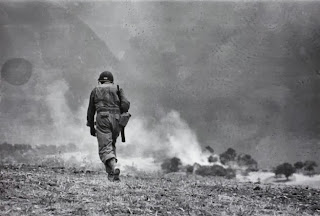Photojournalism War Photography
Robert Capa/Tony Viccaro
- Describe the different circumstances that these photographers experienced as Photojournalists in WW2: Robert Capa sent into WW2 to photograph the war for Lifestyle Magazine he was able to drop in out of the war. Tony Viccaro, a soldier photographing the scenes for for personal use, he had no escape from the war. Both photographed for different reasons but together captured powerful images of the war. Both of their work was to get close, to close in some circumstances. They would risk their lives multiple times to capture these decisive moments, it was that important. Once these images were captured Capa would send them to Lifestyle Magazine to be processed in the dark room but not all went to plan. While being processed the images melted but being rushed and this ruined the photos but their was still one roll of film left and these are images that were released the rest would never be seen. Viccaro, not having the luxury of a magazine processing the images he had to them himself in the battlefield. He found a destroyed camera shop and scrimmaged around to find the chemicals and once he did he would wait until their was no moon light and poor each of the chemicals into soldiers helmets and then hang the images off trees nearby. Once it turned morning he would go to the trees and their was his images although, the army destroyed some of images as they didn't want photos of dead american soldiers being seen by the public.
- Find and upload to your blog some work of theirs:
 |
| Robert Capa |
 |
| Tony Vaccaro |
- Describe the difference between the video footage and the photograph of the "Execution": The differences between the video footage and photograph are quite extensive in my opinion. The video is around 5 seconds long but when I look at the image is find myself looking for around 2 minutes. Video cant show a lot of emotion in a short space of time, you cant see the detail on the mans face as hes being shot, you cant see the muscles tensing in the arm of the shooter. These are all emotional attachments that you miss in the video footage. It like a film, you are just watching whereas as the photo its as though you are the there seeing this man about to be executed. Photojournalism is a way of telling you what has happened or telling a story in a single picture.


No comments:
Post a Comment